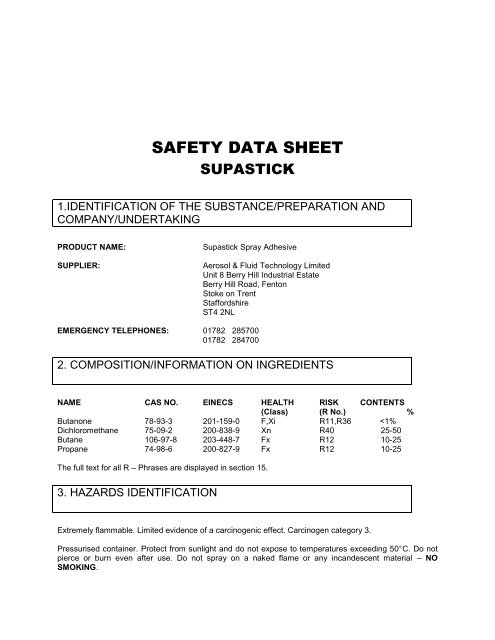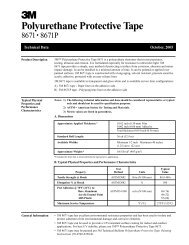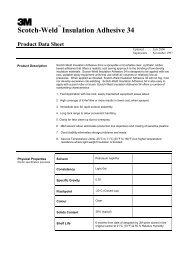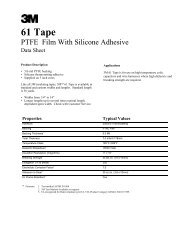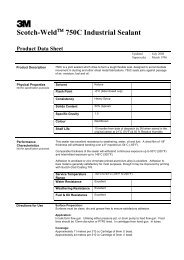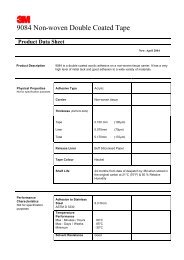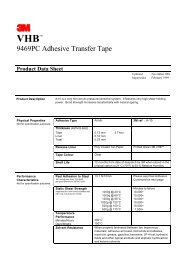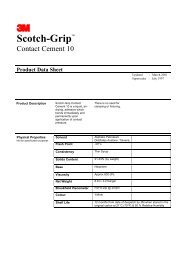Supa Stick - Viking Industrial Products Ltd.
Supa Stick - Viking Industrial Products Ltd.
Supa Stick - Viking Industrial Products Ltd.
Create successful ePaper yourself
Turn your PDF publications into a flip-book with our unique Google optimized e-Paper software.
SAFETY DATA SHEET<br />
SUPASTICK<br />
1.IDENTIFICATION OF THE SUBSTANCE/PREPARATION AND<br />
COMPANY/UNDERTAKING<br />
PRODUCT NAME:<br />
SUPPLIER:<br />
<strong>Supa</strong>stick Spray Adhesive<br />
Aerosol & Fluid Technology Limited<br />
Unit 8 Berry Hill <strong>Industrial</strong> Estate<br />
Berry Hill Road, Fenton<br />
Stoke on Trent<br />
Staffordshire<br />
ST4 2NL<br />
EMERGENCY TELEPHONES: 01782 285700<br />
01782 284700<br />
2. COMPOSITION/INFORMATION ON INGREDIENTS<br />
NAME CAS NO. EINECS HEALTH RISK CONTENTS<br />
(Class) (R No.) %<br />
Butanone 78-93-3 201-159-0 F,Xi R11,R36
4. FIRST AID MEASURES<br />
INHALATION:<br />
INGESTION:<br />
SKIN:<br />
EYES:<br />
Remove the exposed person immediately to fresh air, keep the<br />
patient warm and at rest. If breathing is irregular or has stopped,<br />
administer artificial respiration. Give nothing by mouth. If<br />
unconscious, place in the recovery position. Get prompt medical<br />
attention.<br />
Rinse mouth thoroughly. Do not induce vomiting. Get medical<br />
attention immediately.<br />
Promptly wash contaminated skin with soap or mild detergent<br />
and water. Promptly remove clothing if soaked through and wash<br />
as above. Get medical attention if irritation persists after washing.<br />
Contact lenses should be removed. Promptly wash eyes with<br />
water for at least 15 minutes holding eyelids apart and get<br />
medical attention.<br />
5. FIRE FIGHTING MEASURES<br />
EXTINGUISHING MEDIA:<br />
UNUSAL FIRE &<br />
EXPLOSION HAZARDS:<br />
SPECIAL FIRE FIGHTING<br />
PROCEDURES:<br />
SPECIFIC HAZARDS:<br />
Fire can be extinguished using: Powder, foam or carbon dioxide<br />
(C02).<br />
Aerosol may explode in fires.<br />
Use water spray only to cool containers! Do not put<br />
water on leaked material. If possible, fight fire from protected<br />
position. Wear self contained breathing apparatus.<br />
Toxic gases/vapours/fumes of carbon dioxide (CO2). Carbon<br />
monoxide (CO).<br />
6. ACCIDENTAL RELEASE MEASURES<br />
PERSONAL PRECAUTION<br />
IN SPILL:<br />
PRECAUTIONS TO PROTECT<br />
THE ENVIRONMENT:<br />
Avoid breathing vapour, ensure adequate<br />
ventilation. Avoid skin and eye contact. Wear personal protective<br />
equipment.<br />
Prevent entry into drains and watercourses.
SPILL CLEANUP METHODS:<br />
Extinguish all sources of ignition. Avoid sparks, flames, heat and<br />
smoking. Ventilate. Absorb onto sand, earth or absorbent<br />
granules. Pick up with non sparking tools & place into metal<br />
containers with sealable lids. Mark the<br />
containers with details of hazards and store in designated areas<br />
ready for disposal.<br />
7. HANDLING AND STORAGE<br />
USAGE PRECAUTIONS:<br />
STORAGE PRECAUTIONS:<br />
Keep away from heat, sparks and open flame. Avoid spillage,<br />
skin and eye contact. Ventilate well, avoid breathing vapours.<br />
Use approved respirator if air contamination is above acceptable<br />
level. Do not pierce or burn even when empty.<br />
Flammable/combustible – keep away from oxidisers, heat, sparks<br />
and open flames. Store at moderate temperatures in dry, well<br />
ventilated area. Aerosol cans: Must not be exposed to direct<br />
sunlight or temperatures above 50ºC.<br />
8.EXPOSURE CONTROLS AND PERSONAL PROTECTION<br />
INGREDIENT NAME CAS. No: EINECS STD LT EXP 8hrs ST EXP 15Mi<br />
Dichloromethane 75-09-2 200-838-9 MEL 100 ppm 300ppm<br />
Butane 106-97-8 200-448-7 OES 600 ppm<br />
750ppm<br />
Butanone 78-93-3 201-159-0 WEL 200 ppm (Sk) 300 ppm (Sk)<br />
Propane 74-98-6 200-827-9 Asphyxiating<br />
Asphyxiating<br />
PROTECTIVE EQUIPMENT:<br />
VENTILATION:<br />
RESPIRATORY PROTECTION:<br />
Provide adequate ventilation to ensure the airborne concentration<br />
does not exceed the above levels. Ensure there are no sources<br />
of ignition.<br />
Adequate respiratory protection must be used if air concentration<br />
exceeds acceptable level.
HAND PROTECTION:<br />
EYE PROTECTION:<br />
SKIN PROTECTION:<br />
Protective gloves must be used if there is risk of direct contact or<br />
splash. Use protective gloves made of: Nitrile.<br />
Wear splash proof goggles to prevent any possibility of eye<br />
contact.<br />
Wear appropriate clothing to prevent repeated or prolonged skin<br />
contact.<br />
HYGIENIC WORK PRACTICES:<br />
Wash promptly if skin becomes contaminated. Wash at the end<br />
of each work shift and before eating, smoking and using the<br />
toilet.<br />
9. PHYSICAL AND CHEMICAL PROPERTIES<br />
APPEARANCE:<br />
Aerosol<br />
COLOUR:<br />
Clear<br />
ODOUR/TASTE:<br />
Chlorinated hydrocarbons/solvent<br />
PHYSICAL DATA COMMENTS: Can pressure 70psi<br />
DENSITY/SPECIFIC GRAVITY (v/ml) 0.798<br />
SOLUBILITY DESCRIPTION: Soluble in chlorinated hydrocarbons.<br />
FLASH POINT (°C):<br />
- 40 (propellant)<br />
10. STABILITY AND REACTIVITY<br />
STABILITY:<br />
CONDITIONS TO AVOID:<br />
MATERIAL TO AVOID:<br />
HAZ. DECOMP. PRODUCTS:<br />
Stable under normal conditions. Stable at room temperature.<br />
Heat. Hot surfaces. Sources of ignition. Flames.<br />
Strong oxidising agents. Strong acids and strong alkalis.<br />
In combustion emits toxic fumes of carbon dioxide/ carbon<br />
monoxide / Hydrogen Cyanide.<br />
11.TOXICOLOGICAL INFORMATION<br />
INHALATION:<br />
INGESTION:<br />
SKIN:<br />
Harmful by inhalation. Vapour may effect central nervous system<br />
and cause headache, discomfort, vomiting or intoxication. Gas or<br />
vapour may irritate respiratory system.<br />
May cause discomfort if swallowed.<br />
Prolonged or repeated contact leads to drying of skin. May cause<br />
sensitisation by skin contact.
EYES:<br />
Spray and vapour in eyes may cause irritation and smarting.<br />
OTHER HEALTH EFFECTS: Carcinogen category 3.<br />
12. ECOLOGICAL INFORMATION<br />
ECOLOGICAL INFORMATION:<br />
Contamination of the terrestrial and aquatic environments should<br />
be avoided. Dichloromethane has a low bio – accumulation<br />
potential, very low toxicity to fish and is readily biodegradable.<br />
13. DISPOSAL CONSIDERATIONS<br />
DISPOSAL METHODS:<br />
Dispose of in accordance with Local Authority requirements.<br />
Empty containers must not be burned because of explosion<br />
hazard.<br />
14. TRANSPORT INFORMATION<br />
LABEL FOR CONVEYANCE:<br />
UN No. ROAD: 1950<br />
UK ROAD TRANSPORT CLASS: 2<br />
UK ROAD PACK GR.:<br />
Not Applicable<br />
ADR CLASS No.: 2<br />
ADR CLASS:<br />
2 Gases<br />
ADR PACK GR.:<br />
Not Applicable<br />
ADR LABEL No.: 2.1<br />
PROPER SHIPPING NAME:<br />
AEROSOLS<br />
RID CLASS No.: 2<br />
RID CLASS GR.:<br />
Not Applicable
UN No. SEA: 1950<br />
IMDG CLASS: 2<br />
IMDG PACK GR.:<br />
Not Applicable<br />
MARINE POLLUTANT:<br />
No.<br />
UN No. AIR: 1950<br />
ICAO CLASS: 2.1<br />
AIR SUB CLASS: 2.1<br />
AIR PACK GR.:<br />
Not Applicable<br />
15.REGULATORY INFORMATION<br />
LABEL FOR SUPPLY:<br />
CONTAINS:<br />
DICHLOROMETHANE<br />
RISK PHRASES: R-12 Extremely Flammable.<br />
R-40 Limited evidence of carcinogenic effect.<br />
SAFETY PHRASES: S-2 Keep out of reach of children.<br />
S-13 Keep away from food, drink and animal<br />
feeding stuffs.<br />
S-16 Keep away from all sources of ignition –<br />
NO SMOKING.<br />
S-23 Do not breathe spray.<br />
S-24/25 Avoid contact with skin and eyes.<br />
S-26 In case of contact with eyes, rinse immediately<br />
with plenty of water and seek medical advice.<br />
S-36/37/39 Wear suitable protective clothing, gloves<br />
and eye/face protection.<br />
S-46 If swallowed seek medical advice immediately
and show this container or label.<br />
S-51 Use only in well ventilated areas.<br />
16. OTHER INFORMATION<br />
USER NOTES:<br />
APPLICATION EVALUATION:<br />
LIMITATIONS:<br />
SHELF LIFE:<br />
CAUTION:<br />
This product should be used as directed by Aerosol & Fluid<br />
Technology Limited. For further information consult the product<br />
data sheet or contact Technical Services.<br />
An evaluation of this product should be carried out in application<br />
conditions before commercial use is undertaken. This should also<br />
include a reference to ageing.<br />
This product is not suitable for highly plasticised PVC.<br />
Unless stated otherwise this product has a shelf life of 12 months<br />
from purchase date.<br />
Pressurised container. Do not expose to temperatures exceeding<br />
50°C. Protect from sunlight. Do not puncture or incinerate even<br />
when empty. Do not spray onto naked flame or any incandescent<br />
material.<br />
DISPOSAL CONSIDERATIONS:<br />
INFORMATION SOURCES:<br />
REVISION COMMENTS:<br />
This material and its container must be disposed of in a safe way.<br />
This safety data sheet was compiled using current safety<br />
information supplied by distributors of raw materials.<br />
This safety data sheet supersedes all previous issues and users<br />
are cautioned to ensure that it is current. Destroy all previous<br />
data sheets and if in doubt contact Aerosol & Fluid Technology<br />
Limited.<br />
ISSUE: F/1<br />
REVISION DATE: FEBRUARY 2008<br />
REVIEW DATE: MARCH 2009
This advice is given by Aerosol & Fluid Technology Limited who accepts no legal liability for it. The<br />
information herein is based on the present state of our knowledge and is intended to describe our<br />
products from the point of view of safety requirements. It should not therefore, be construed as<br />
guaranteeing specific properties.


